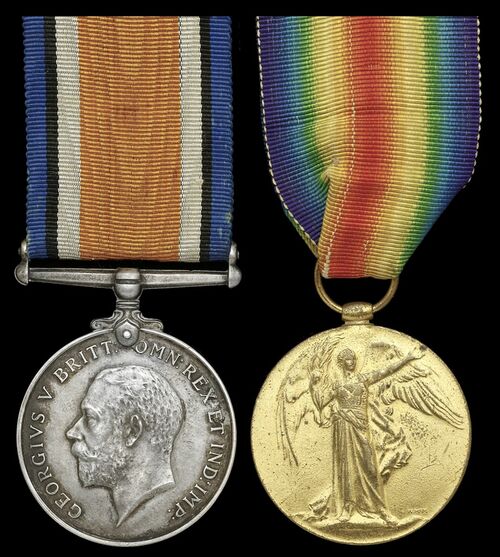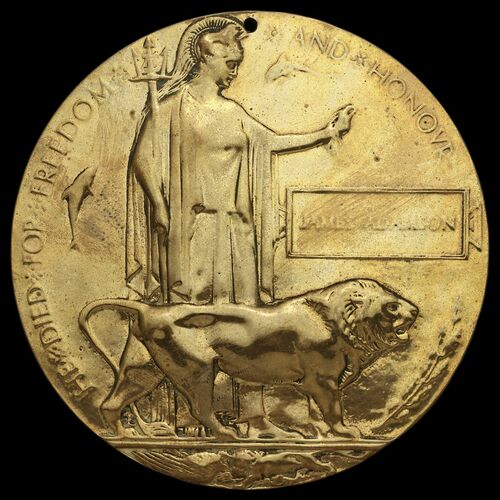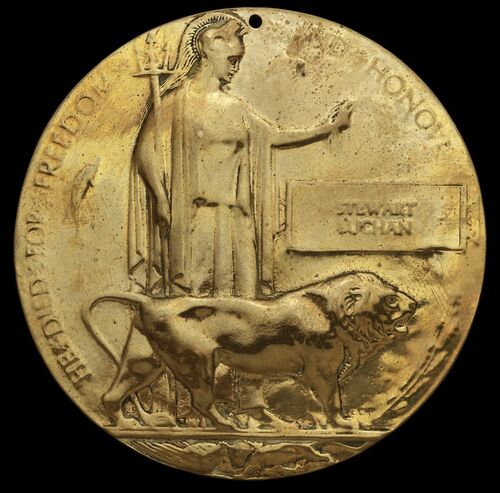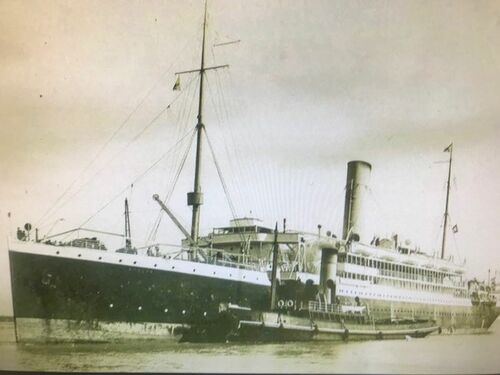Auction: 23003 - Orders, Decorations and Medals
Lot: 88
A poignant family group:
A Great War casualty group of four awarded to Able Seaman S. Buchan, Royal Navy, who was aboard the S.S. Rio Verde when she was torpedoed by U-100 on 21 February 1918
1914-15 Star (171895, S. Buchan, A.B., R.N.); British War and Victory Medals (171895 S. Buchan. A.B. R.N.); Great War Bronze Memorial Plaque (Stewart Buchan), very fine
The campaign group of three awarded to Private J. Anderson, Cheshire Regiment who was aboard the Aragon which was torpedoed outside Alexandria
British War and Victory Medals (4020 Pte. J. Adamson. Ches. R); Great War Bronze Memorial Plaque (James Adamson), both plaques drilled at 12 o'clock and polished, the medals good very fine (Lot)
Stewart Buchan was born on 9 September 1877 at Liverpool and enlisted on 2 February 1893 as a Boy 2nd Class. Promoted to Ordinary Seaman on 9 September 1895 and then to Able Seaman on 18 October 1898. He was serving aboard the Sphinx when he invalided with Beriberi in Bombay. Re-enrolled for a further period to the age of 40 years, on 12 October 1912. During the Great War he was unfortunate to be aboard the Rio Verde, which was a cargo ship was torpedoed and sunk in then Irish Sea 4 nautical miles (7.4 km) off Crammock Head, Wigtownshire by the U-100. He is buried in Dundalk (St.Patrick's) Cemetery, Ireland and was subsequently awarded a Royal Fleet Reserve Gratuity of £50 in July 1918 and a further Supplementary Prize Share on 8 September 1923.
James Adamson was born at Walton, Lancashire and enlisted at Birkenhead. He died at sea on 30 December 1917, whilst serving with the 1/4th Battalion, Cheshire Regiment and is commemorated on the Chatby Memorial, Alexandria, Egypt. From the records on the Commonwealth War Graves Commission website it seems he was aboard Aragon". Aragon and Attack were in Alexandria Roads about 10 miles outside the port, awaiting permission to enter, when at 1100hrs the UC-34 torpedoed Aragon, hitting her port side aft and causing extensive damage in her almost empty No. 4 hold. Aragon's Deck Officer of the Watch, Lieutenant J. F. A. Thompson, stated that she then listed to starboard.
Attack and Points Castle came to the rescue. One account states that two trawlers were present. The V.A.D.s were ordered into the first lifeboats to be launched. Two or three of the V.A.D.s protested at being given priority and one pleaded '...let us take our chance with the Tommies' before they all obeyed orders. Their boats rescued some troops from the water and then transferred their survivors to one or two trawlers. Aragon released her life rafts but the explosion had smashed one of her lifeboats and her increasing list prevented her crew from launching some of the remainder. Aragon's crew worked until they were waist deep in water to launch what boats they could.
Attack drew right alongside Aragon to take survivors aboard as quickly as possible, helped by lines cast between the two ships. The troop ship sank rapidly by the stern. More than one survivor stated that soldiers waiting on deck to be rescued started singing. One said '...I have heard the chorus 'Keep the Home Fires Burning' on many occasions but I don't think that I have ever heard it given with so much power.'
By now there was an increasing number of men in the water, and Trooper James Werner Magnusson of the New Zealand Mounted Rifles saw an injured soldier struggling in the very rough sea. He dived overboard from the ship, rescued the man and placed him in a boat. Magnusson then returned aboard, rejoined his unit, and went down with the ship. He was posthumously awarded the Albert Medal.
A draft of 3rd (Reserve) Battalion, Buffs (East Kent Regiment) sent to reinforce the 10th (Royal East Kent and West Kent Yeomanry) Battalion, Buffs, won high praise for its discipline. First, Lance-Sergeant Canfor (himself injured by the explosion) called the roll, then men were detailed to cut away the life rafts while the rest sang. When the rafts were launched Lance-Corporal Baker volunteered to jump into the water to secure a life raft that was drifting away, assuring the safety of about 20 men. The rest of the draft then entered the water and clung onto the rafts for two and a half hours, singing and cheering on the rescue efforts. Only one man of the draft was lost.
About 15 minutes after the torpedo struck Aragon, her Master, Captain Bateman, gave the order from her bridge 'Every man for himself'. Those remaining aboard rushed to get over her side, and her bow rose out of the sea as soldiers swarmed down her side into the water. One of the V.A.D.s who survived later recorded '...we felt that all our friends were drowning before our eyes.'
Just 20 minutes after being hit Aragon went down, and she suffered a second explosion as the cold seawater reached her hot boilers. Some of her boats were left upturned in the water.
Attack was now crowded with 300-400 survivors: some naked, some wounded, many unconscious and dying. One soldier, Sergeant Harold Riddlesworth of the Cheshire Regiment, repeatedly dived from the destroyer into the sea to rescue more survivors. He survived and was decorated with the Meritorious Service Medal.
Then a torpedo struck Attack amidships and blew her into two pieces, both of which sank with five to seven minutes. The explosion ruptured Attack's bunkers, spilling tons of thick, black bunker fuel oil into the sea as she sank. Hundreds of men were in the water, and many of them became covered in oil or overcome by its fumes.
Aragon's surviving lifeboats now ferried hundreds of survivors to the trawlers, where the V.A.D.s '...worked unceasingly and with great heroism' to tend the many wounded. Other trawlers came out to assist, and the first trawler or trawlers returned to harbour for safety.
Of those aboard Aragon, 610 were killed including Captain Bateman, 19 of his crew, and six of the V.A.D.s. Hundreds of troops were killed. Soldiers killed in the sinking are among those commemorated by the Chatby Memorial in the Shatby district of eastern Alexandria.
Many of the survivors from Aragon's crew were repatriated to England, reaching Southampton on 10 February 1918. Some voyaged all the way by steamship, but the majority travelled overland.
Both groups came from the same family and the Plaques have equal wear so the two are somehow related here. Sold together with the following original archive:
(i)
Certificate of Service.
(ii)
A collection of Telegrams, the first dated 27 February 1918 to his wife stating that his body was not amongst those recovered. This is followed by more confirming that his body was found on the 7 March 1918 and had been identified as Buchan and in turn was buried in Dundalk.
(iii)
Card mounted photographs of him and others in uniform whilst serving in Hong Kong.
(iv)
A further larger photograph of him manning the wheel in Hong Kong.
(v)
Two hand painted pictures of him, both in uniform, one of which has him wearing an H.M.S. Amphrite cap tally next to his son.
(vi)
Postcard sent to his wife.
(vii)
National Health Insurance Book to James Buchan.
Subject to 20% VAT on Buyer’s Premium. For more information please view Terms and Conditions for Buyers.
Sold for
£400
Starting price
£400
Sale 23003 Notices
'Now also accompanied with Ministry of Shipping and Irish Office of Public Works related to their deaths, besides a series of photographs.'













